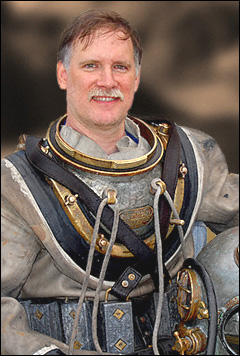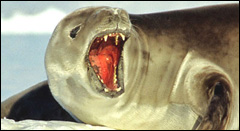Meet Chris Weaver
November 12, 2007

Chris Weaver
When plunging into waters inhabited by great white sharks, Chris Weaver will tell you that half of the preparation is mental. As a certified scuba diver since 1978, the Information Technology Division web developer has made hundreds of dives with a childhood friend, taking photographs of their experiences in remote locations ranging from the temperate waters of Cocos Island, Truk Lagoon, and the Galapagos Islands, to the frozen waters of Antarctica.
What started as a hobby has turned into a small side business called Eco-Photo Explorers, formed by Weaver and his friend, Michael Salvarezza, in 1994. Its mission is to promote public awareness about protecting the underwater environment by using their underwater photography.
"Divers have a unique opportunity to view pollution in a way that others cannot," Weaver said. "You see trash beneath the surface, you see how people mutilate animals, and how corporations are inadvertently killing animals that are not part of their catch. You get in the state of mind that even though you're just diving in the ocean for a short period of time, you're an ambassador of this underwater world and you can't just take without giving back. We're graced with being able to go down there and experience all of the beauty, so we want to show others that it needs to be protected."
Every year, Weaver and Salvarezza present 20 to 25 multimedia programs and lectures based on their diving experiences to audiences at libraries, schools, and elsewhere. Their photography and writing have been featured in numerous publications such as National Geographic Adventure, and used by educational and environmental organizations including Beneath the Sea, the Boston Sea Rovers, and the Atlantis Marine World Aquarium.

To see more photos of animals like this Crabeater seal, be sure to check out Chris' work.
The pair has shot as many as 2,700 digital photos on a single dive expedition — 75 rolls of 36-exposure film in the old days. Weaver's favorite location is Antarctica, where he's been twice and where the 28-degree water usually limits a diver to a brief 20-30 minute dive.
"It's still untouched by us," said Weaver, whose childhood heroes were explorers like Jacques-Yves Cousteau. "It's still pure and wild and gives you the frame of mind of a modern-day explorer."
And about those sharks: "It can be scary," Weaver said. "But you just have to remember that you are in their domain. Stay calm, and know how you're going to cope with a situation should it arise."
For more information about Eco-Photo Explorers, check out the website.
Think you or one of your colleagues has a good story to tell? Email us! Although we can't write about everyone, we would love to hear your ideas and suggestions.
2007-429 | INT/EXT | Newsroom









